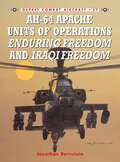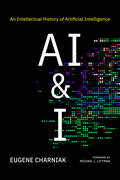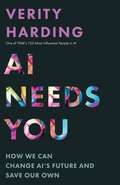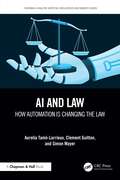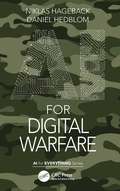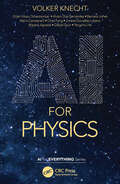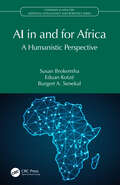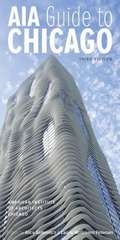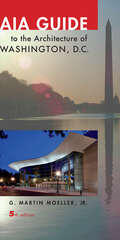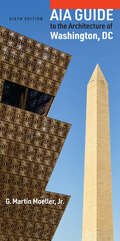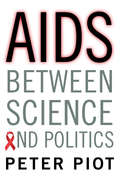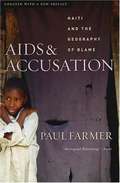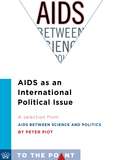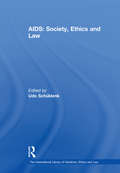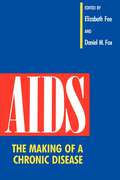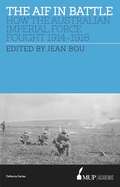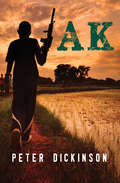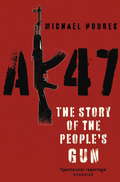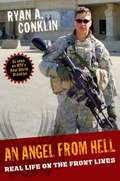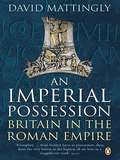- Table View
- List View
AH-64 Apache Units of Operations Enduring Freedom & Iraqi Freedom
by Jim Laurier Jonathan BernsteinAfter the attacks on 11 September 2001, Apache units made significant contributions to the Coalition campaign against Taliban and al-Qaeda forces in Afghanistan. Functioning as the 'killer' part of US Army Hunter-killer teams, Apaches sought out and brought overwhelming firepower to bear on Taliban and al-Qaeda forces, as well as providing direct support to Coalition troops on the ground. Apaches spearheaded the advance of the 3rd Infantry and the 101st airborne divisions into Iraq, engaging in some of the heaviest fighting along the western axis of advance. Weather and enemy fire took a heavy toll on Apaches operating in Western Iraq, but the resilience and flexibility of the Apache was central to the success of this campaign.
AI & I: An Intellectual History of Artificial Intelligence
by Eugene CharniakA concise and illuminating history of the field of artificial intelligence from one of its earliest and most respected pioneers.AI & I is an intellectual history of the field of artificial intelligence from the perspective of one of its first practitioners, Eugene Charniak. Charniak entered the field in 1967, roughly 12 years after AI&’s founding, and was involved in many of AI&’s formative milestones. In this book, he traces the trajectory of breakthroughs and disappointments of the discipline up to the current day, clearly and engagingly demystifying this oft revered and misunderstood technology. His argument is controversial but well supported: that classical AI has been almost uniformly unsuccessful and that the modern deep learning approach should be viewed as the foundation for all the exciting developments that are to come.Written for the scientifically educated layperson, this book chronicles the history of the field of AI, starting with its origin in 1956, as a topic for a small academic workshop held at Dartmouth University. From there, the author covers reasoning and knowledge representation, reasoning under uncertainty, chess, computer vision, speech recognition, language acquisition, deep learning, and learning writ large. Ultimately, Charniak takes issue with the controversy of AI—the fear that its invention means the end of jobs, creativity, and potentially even humans as a species—and explains why such concerns are unfounded. Instead, he believes that we should embrace the technology and all its potential to benefit society.
AI Needs You: How We Can Change AI's Future and Save Our Own
by Verity HardingA humanist manifesto for the age of AIArtificial intelligence may be the most transformative technology of our time. As AI&’s power grows, so does the need to figure out what—and who—this technology is really for. AI Needs You argues that it is critical for society to take the lead in answering this urgent question and ensuring that AI fulfills its promise.Verity Harding draws inspiring lessons from the histories of three twentieth-century tech revolutions—the space race, in vitro fertilization, and the internet—to empower each of us to join the conversation about AI and its possible futures. Sharing her perspective as a leading insider in technology and politics, she rejects the dominant narrative, which often likens AI&’s advent to that of the atomic bomb. History points the way to an achievable future in which democratically determined values guide AI to be peaceful in its intent; to embrace limitations; to serve purpose, not profit; and to be firmly rooted in societal trust.AI Needs You gives us hope that we, the people, can imbue AI with a deep intentionality that reflects our best values, ideals, and interests, and that serves the public good. AI will permeate our lives in unforeseeable ways, but it is clear that the shape of AI&’s future—and of our own—cannot be left only to those building it. It is up to us to guide this technology away from our worst fears and toward a future that we can trust and believe in.
AI Needs You: How We Can Change AI's Future and Save Our Own
by Verity HardingA humanist manifesto for the age of AIArtificial intelligence may be the most transformative technology of our time. As AI&’s power grows, so does the need to figure out what—and who—this technology is really for. AI Needs You argues that it is critical for society to take the lead in answering this urgent question and ensuring that AI fulfills its promise.Verity Harding draws inspiring lessons from the histories of three twentieth-century tech revolutions—the space race, in vitro fertilization, and the internet—to empower each of us to join the conversation about AI and its possible futures. Sharing her perspective as a leading insider in technology and politics, she rejects the dominant narrative, which often likens AI&’s advent to that of the atomic bomb. History points the way to an achievable future in which democratically determined values guide AI to be peaceful in its intent; to embrace limitations; to serve purpose, not profit; and to be firmly rooted in societal trust.Now with a new foreword by the author, AI Needs You gives us hope that we, the people, can imbue AI with a deep intentionality that reflects our best values, ideals, and interests, and that serves the public good. AI will permeate our lives in unforeseeable ways, but it is clear that the shape of AI&’s future—and of our own—cannot be left only to those building it. It is up to us to guide this technology away from our worst fears and toward a future that we can trust and believe in.
AI and Law: How Automation is Changing the Law (Chapman & Hall/CRC Artificial Intelligence and Robotics Series)
by Aurelia Tamo-Larrieux Clement Guitton Simon MayerThis book provides insights into how AI is changing legal practice, government processes, and individuals’ access to those processes, encouraging each of us to consider how technological advances are changing the legal system. Particularly, and distinct from current debates on how to regulate AI, this books focuses on how the progressive merger between computational methods and legal rules changes the very structure and application of the law itself.We investigate how automation is changing the legal analysis, legal rulemaking, legal rule extraction, and application of legal rules and how this impacts individuals, policymakers, civil servants, and society at large. We show through many examples that a debate on how automation is changing the law is needed, which must revolve around the democratic legitimacy of the automation of legal processes, and be informed by the technical feasibility and tradeoffs of specific endeavors.
AI for Digital Warfare (AI for Everything)
by Niklas Hageback Daniel HedblomAI for Digital Warfare explores how the weaponising of artificial intelligence can and will change how warfare is being conducted, and what impact it will have on the corporate world. With artificial intelligence tools becoming increasingly advanced, and in many cases more humanlike, their potential in psychological warfare is being recognised, which means digital warfare can move beyond just shutting down IT systems into more all-encompassing hybrid war strategies.
AI for Physics (AI for Everything)
by Volker KnechtWritten in accessible language without mathematical formulas, this short book provides an overview of the wide and varied applications of artificial intelligence (AI) across the spectrum of physical sciences. Focusing in particular on AI's ability to extract patterns from data, known as machine learning (ML), the book includes a chapter on important machine learning algorithms and their respective applications in physics. It then explores the use of ML across a number of important sub-fields in more detail, ranging from particle, molecular and condensed matter physics, to astrophysics, cosmology and the theory of everything. The book covers such applications as the search for new particles and the detection of gravitational waves from the merging of black holes, and concludes by discussing what the future may hold.
AI in and for Africa: A Humanistic Perspective (Chapman & Hall/CRC Artificial Intelligence and Robotics Series)
by Susan Brokensha Eduan Kotzé Burgert A. SenekalAI in and for Africa: A Humanistic Perspective explores the convoluted intersection of artificial intelligence (AI) with Africa’s unique socio-economic realities. This book is the first of its kind to provide a comprehensive overview of how AI is currently being deployed on the African continent. Given the existence of significant disparities in Africa related to gender, race, labour, and power, the book argues that the continent requires different AI solutions to its problems, ones that are not founded on technological determinism or exclusively on the adoption of Eurocentric or Western-centric worldviews. It embraces a decolonial approach to exploring and addressing issues such as AI’s diversity crisis, the absence of ethical policies around AI that are tailor-made for Africa, the ever-widening digital divide, and the ongoing practice of dismissing African knowledge systems in the contexts of AI research and education. Although the book suggests a number of humanistic strategies with the goal of ensuring that Africa does not appropriate AI in a manner that is skewed in favour of a privileged few, it does not support the notion that the continent should simply opt for a "one-size-fits-all" solution either. Rather, in light of Africa’s rich diversity, the book embraces the need for plurality within different regions’ AI ecosystems. The book advocates that Africa-inclusive AI policies incorporate a relational ethics of care which explicitly addresses how Africa’s unique landscape is entwined in an AI ecosystem. The book also works to provide actionable AI tenets that can be incorporated into policy documents that suit Africa’s needs. This book will be of great interest to researchers, students, and readers who wish to critically appraise the different facets of AI in the context of Africa, across many areas that run the gamut from education, gender studies, and linguistics to agriculture, data science, and economics. This book is of special appeal to scholars in disciplines including anthropology, computer science, philosophy, and sociology, to name a few.
AI, AR, and VR in Theatre and Performance: Technology in the Present and Future of Live Creative Arts
by Shane PikeAI, AR, and VR in Theatre and Performance investigates the cutting-edge application of evolving digital technologies within the creative industries, with a focus on theatre and the dramatic arts.Grounded in a practice-based approach, this book explores the experiences of creatives, producers, and IT-specialist content creators employing artificial intelligence (AI), augmented reality (AR), and virtual reality (VR) technologies. A series of international case studies are presented, demonstrating current techno-infused practices, as well as potential futures for these technologies within the broadest of creative contexts. Framed by a rigorous ethnodramatic methodological approach, the book examines the practical applications of contemporary digital technologies in theatre and other live performance settings and provides a scaffolding framework for readers to adopt in their own practice. It also proposes groundbreaking ideas for the classification of how AI may be used in current and future artistic practices, the ‘three Cs of AI,’ and introduces the concept of Communal Augmented Reality – Live (CARL) as the most likely form to advance the incorporation of emerging technologies onto the live stage. The works of Belgium’s VR immersive experiences company CREW, Singapore-based film and visual artist Ho Tzu Nyen, and the Tamil language theatre company AGAM Theatre Lab are detailed alongside the world-first application of AR holographic technology in Australia, before unpacking the pioneering advancements in algorithmic and AI theatre of America’s Annie Dorsen.With a practice-based, artist-led perspective and contributions from technologists, this book offers a comprehensive and accessible resource that will appeal to a diverse audience of artists, academics, students, practitioners, creative engineers/content creators, animators, and theorists with an interest in the relationship between digital technologies and live performance.
AIA Guide to Chicago
by Geoffrey Baer Alice Sinkevitch American Institute of Architects Chicago Laurie Mcgovern Petersen Perry DuisAn unparalleled architectural powerhouse, Chicago offers visitors and natives alike a panorama of styles and forms. The third edition of the AIA Guide to Chicago brings readers up to date on ten years of dynamic changes with new entries on smaller projects as well as showcases like the Aqua building, Trump Tower, and Millennium Park. Four hundred photos and thirty-four specially commissioned maps make it easy to find each of the one thousand-plus featured buildings, while a comprehensive index organizes buildings by name and architect. This edition also features an introduction providing an indispensable overview of Chicago's architectural history.
AIA Guide to the Architecture of Washington, D.C.
by G. Martin Moeller Jr.Third Place Winner, Design and Effectiveness Award of the Washington PublishersThis lively and informative guide offers tourists, residents, and architecture aficionados alike insights into more than 400 of Washington, D.C.’s, most important landmarks. Organized into 19 discrete tours, this thoroughly redesigned and updated edition includes 45 new entries, encompassing the House of Sweden and the U.S. Institute of Peace, classic buildings that epitomize the city—the White House, the Capitol, Union Station—and a number of private buildings off the beaten path.G. Martin Moeller, Jr., blends informed, concise descriptions with engaging commentary on each landmark, revealing often-surprising details of the buildings' history and design. Every entry is accompanied by a photograph and includes the structure's location, its architects and designers, and the corresponding dates of completion. Each entry is keyed to an easy-to-read map at the beginning of the tour.From the imposing monuments of Capitol Hill and the Mall to the pastoral suburban enclaves of Foxhall and Cleveland Park, from small memorials to vast commercial and institutional complexes, this guide shows us a Washington that is at once excitingly fresh and comfortably familiar.
AIA Guide to the Architecture of Washington, DC
by G. Martin Moeller Jr."The model of what a concise, attractive guidebook should be."—Mid-Atlantic CountryThis lively and informative guide offers tourists, residents, and architecture aficionados insights into nearly 450 of Washington, DC's, most noteworthy buildings and monuments. Organized into 19 discrete walking tours, plus one general tour of peripheral sites, this thoroughly revised sixth edition features projects ranging from early federal landmarks to twenty-first-century commercial, institutional, and residential buildings. It includes some 80 new entries covering dozens of recently completed buildings, along with some historic structures that may have been overlooked in the past. The guide also has updated maps, and many existing entries have been rewritten to reflect recent renovations, changes to the buildings' contexts, or additional scholarship.G. Martin Moeller, Jr., blends informed, concise descriptions with engaging commentary on each landmark, revealing surprising details of the buildings' history and design. Every entry is accompanied by a photograph and includes the structure's location, its architects and designers, and the corresponding dates of completion. Each entry is keyed to an easy-to-read map at the beginning of the tour.From the imposing monuments of Capitol Hill and the Mall to the pastoral suburban enclaves of Foxhall and Cleveland Park, from small memorials to vast commercial and institutional complexes, this guide shows us a Washington that is at once excitingly fresh and comfortably familiar. The additions and revisions incorporated into the latest edition illuminate broader demographic and physical changes in the city, including the emergence of new neighborhoods and the redevelopment of once-neglected areas.
AIDS Between Science and Politics: A Selection From Aids Between Science And Politics (To The Point Ser.)
by Peter PiotPeter Piot, founding executive director of the Joint United Nations Programme on HIV/AIDS (UNAIDS), recounts his experience as a clinician, scientist, and activist fighting the disease from its earliest manifestation to today. The AIDS pandemic was not only catastrophic to the health of millions worldwide but also fractured international relations, global access to new technologies, and public health policies in nations across the globe. As he struggled to get ahead of the disease, Piot found science does little good when it operates independently of politics and economics, and politics is worthless if it rejects scientific evidence and respect for human rights. <P><P>Piot describes how the epidemic altered global attitudes toward sexuality, the character of the doctor-patient relationship, the influence of civil society in international relations, and traditional partisan divides. AIDS thrust health into national and international politics where, he argues, it rightly belongs. The global reaction to AIDS over the past decade is the positive result of this partnership, showing what can be achieved when science, politics, and policy converge on the ground. Yet it remains a fragile achievement, and Piot warns against complacency and the consequences of reduced investments. He refuses to accept a world in which high levels of HIV infection are the norm. Instead, he explains how to continue to reduce the incidence of the disease to minute levels through both prevention and treatment, until a vaccine is discovered.
AIDS Doctors: An Oral History
by Ronald Bayer Gerald M. OppenheimerToday, AIDS has been indelibly etched in our consciousness. Yet it was less than twenty years ago that doctors confronted a sudden avalanche of strange, inexplicable, seemingly untreatable conditions that signaled the arrival of a devastating new disease. Bewildered, unprepared, and pushed to the limit of their diagnostic abilities, a select group of courageous physicians nevertheless persevered. This unique collective memoir tells their story. <p><p> Based on interviews with nearly eighty doctors whose lives and careers have centered on the AIDS epidemic from the early 1980s to the present, this candid, emotionally textured account details the palpable anxiety in the medical profession as it experienced a rapid succession of cases for which there was no clinical history. The physicians interviewed chronicle the roller coaster experiences of hope and despair, as they applied newly developed, often unsuccessful therapies. Yet these physicians who chose to embrace the challenge confronted more than just the sense of therapeutic helplessness in dealing with a disease they could not conquer. They also faced the tough choices inherent in treating a controversial, sexually and intravenously transmitted illness as many colleagues simply walked away. Many describe being gripped by a sense of mission: by the moral imperative to treat the disempowered and despised. Nearly all describe a common purpose, an esprit de corps that bound them together in a terrible yet exhilarating war against an invisible enemy. <p> This extraordinary oral history forms a landmark effort in the understanding of the AIDS crisis. Carefully collected and eloquently told, the doctors' narratives reveal the tenacity and unquenchable optimism that has paved the way for taming a 20th-century plague.
AIDS and Accusation: Haiti and the Geography of Blame
by Paul FarmerExposes the racism inherent in the now-discredited supposition that AIDS came to the US via Haiti. (It was the other way around.) Award-winning author Paul Farmer, now working in Rwanda, updates this 1992 study with a new preface.
AIDS as an International Political Issue: A Selection from AIDS Between Science and Politics (To the Point)
by Peter PiotPeter Piot, founding executive director of the Joint United Nations Programme on HIV/AIDS (UNAIDS), reports on the influence of civil society in international relations and traditional partisan divides. AIDS thrust health into national and international politics where, he argues, it rightly belongs. The global reaction to AIDS over the past decade is the positive result of this partnership, showing what can be acheved when science, politics, and policy converge on the ground. Piot describes funding mechanisms for AIDS, the first international declarations, the response of the UN system, the establishment of UNAIDS, the response of high income countries to AIDS, The Global Fund and PEPFAR as game-changers, and lessons for other health problems.
AIDS: Society, Ethics and Law
by Udo SchüklenkThis volume features a collection of the most important articles on the social, ethical and legal implications of a variety of problems caused by AIDS. The wide range of articles selected for inclusion were chosen on the basis of three criteria: their theoretical depth and coherence, their impact on the subsequent debate and on the social and ethical relevance of the problems addressed. Sections in the book include: physicians and patients, AIDS and the law, HIV testing, clinical research in developed countries, clinical research in developing countries and dying with dignity
AIDS: The Making of a Chronic Disease
by Daniel M. Fox Elizabeth FeeWhen AIDS was first recognized in 1981, most experts believed that it was a plague, a virulent unexpected disease. They thought AIDS, as a plague, would resemble the great epidemics of the past: it would be devastating but would soon subside, perhaps never to return. By the middle 1980s, however, it became increasingly clear that AIDS was a chronic infection, not a classic plague.In this follow-up to AIDS: The Burdens of History, editors Elizabeth Fee and Daniel M. Fox present essays that describe how AIDS has come to be regarded as a chronic disease. Representing diverse fields and professions, the twenty-three contributors to this work use historical methods to analyze politics and public policy, human rights issues, and the changing populations with HIV infection. They examine the federal government's testing of drugs for cancer and HIV, and show how the policy makers' choice of a specific historical model (chronic disease versus plague) affected their decisions. A powerful photo essay reveals the strengths of women from various backgrounds and lifestyles who are coping with HIV. A sensitive account of the complex relationships of the gay community to AIDS is included. Finally, several contributors provide a sampling of international perspectives on the impact of AIDS in other nations.
AIF in Battle: How the Australian Imperial Force Fought, 1914–1918
by Jean BouBy the end of the First World War the combat formations of the Australian Imperial Force (AIF) in both France and the Middle East were considered among the British Empire's most effective troops. While sometimes a source of pride and not a little boasting, how the force came to be so was not due to any inherent national prowess or trait. Instead it was the culmination of years of training, organisational change, battlefield experimentation and hard-won experience—a process that included not just the Australians, but the wider British imperial armies as well.This book brings together some of Australia's foremost military historians to outline how the military neophytes that left Australia's shores in 1914 became the battle winning troops of 1918. It will trace the evolution of several of the key arms of the AIF, including the infantry, the light horse, the artillery, and the flying corps, and also consider how the various arms worked together alongside other troops of the British Empire to achieve a remarkably high level of battlefield effectiveness.
AK
by Peter DickinsonA war behind him, a child soldier tries to learn the ways of peace Paul remembers nothing from before the conflict. Twelve years old, he is not a child. He is a warrior--one of a handful of elite commandos who live only to fight the corrupt government of Nagala. He has no family but the boys who fight beside him, and he owns nothing but his AK-47 rifle. This is the only life he has ever known, and it is one he understands--right until the day the standoff ends and his life changes forever. Paul buries his AK and heads north to join a school and attempt to live life as just another child. But at night, the battlefield consumes his dreams. When a rogue faction stages a coup in the capital and Paul's adoptive father is put in prison, the boy turns into a warrior once more. It is too late for him to have a childhood, but Paul will do whatever it takes to guarantee himself a future. This ebook features an illustrated personal history of Peter Dickinson including rare images from the author's collection.
AK47: The Story of the People's Gun
by Michael HodgesIn the sixty years since General Kalashnikov created the AK's distinctive silhouette, the gun has been at the centre of conflicts across the Middle East, Africa and Latin America. The weapon that made him a 'Hero of the Soviet Union' has also appeared on t-shirts and vodka bottles, featured in videos and song lyrics and been re-fashioned in crystal - a gift from Putin to George W. Bush. Power, politics and passion combine in the story of a weapon that has shaped the modern world. Using testimonies of people who have experienced the gun at first-hand - including a Sudanese child soldier, a Vietcong veteran and a Yorkshire teenager - Michael Hodges provides a compelling account of how the AK47 became an icon that ranks alongside Coca-Cola as one of the most recognisable brands in the world.
AK47: The Story of the People's Gun
by Michael HodgesIn the sixty years since General Kalashnikov created the AK's distinctive silhouette, the gun has been at the centre of conflicts across the Middle East, Africa and Latin America. The weapon that made him a 'Hero of the Soviet Union' has also appeared on t-shirts and vodka bottles, featured in videos and song lyrics and been re-fashioned in crystal - a gift from Putin to George W. Bush. Power, politics and passion combine in the story of a weapon that has shaped the modern world. Using testimonies of people who have experienced the gun at first-hand - including a Sudanese child soldier, a Vietcong veteran and a Yorkshire teenager - Michael Hodges provides a compelling account of how the AK47 became an icon that ranks alongside Coca-Cola as one of the most recognisable brands in the world.
AN AUTOBIOGRAPHY OR My Experiments with Truth
by Mohandas Karamchand GandhiAn Autobiography of Gandhiji. Translation, Abridgement and Epilogue by Dr. Varsha Das
AN Angel From Hell
by Ryan A. ConklinWith new material- the gripping war memoir by a young veteran and cast member of The Real World: Brooklyn. With new material about Ryan Conklin's second tour in Iraq, An Angel from Hell is a gritty, blunt, sometimes laugh-out-loud Iraq war memoir from the grunt's perspective. This is an edgy, candid report from the front lines and a captivating coming-of-age story by a young veteran and former cast member of The Real World: Brooklyn. With stunning candor and wisdom beyond his years, Ryan Conklin gives voice to a complex and life-changing experience for his generation.
AN Imperial Possession
by David MattinglyThe definitive history of Roman Britain In the first major narative history of the subject in more than a generation, David Mattingly brings life in Britain during four hundred years of Roman domination into vivid relief. Drawing on a wealth of new research and cutting through the myths and misunderstandings that commonly surround most perceptions of Roman Britain, An Imperial Possession describes a remote and culturally diverse province that required a heavy military presence both to keep its subjects in order and to exploit its resources for the empire. With his wonderful addition to the Penguin History of Britain series, ?Mattingly shows . . . just how interesting life could be on the outer fringes of the Roman Empire? (The Sunday Telegraph).
